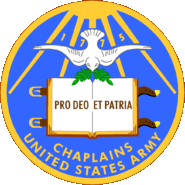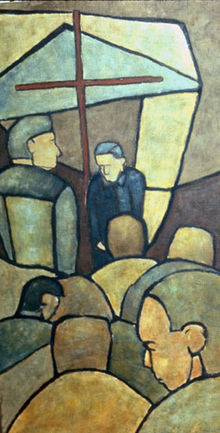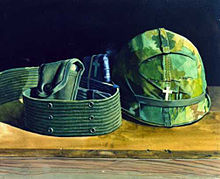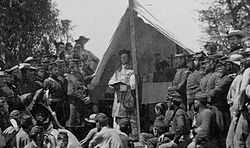- Chaplain Corps (United States Army)
-
United States Army
Chaplain Corps
United States Army Chaplain Corps
Branch PlaqueActive 29 July 1775 – present Country  United States of America
United States of AmericaAllegiance  United States of America
United States of AmericaBranch  United States Army
United States ArmyType Corps Role Military Chaplaincy Size 2,700 Motto "Pro Deo et Patria"
(Latin: For God and Country)Colors Black Engagements American Revolutionary War
American Civil War
Spanish-American War
World War I
World War II
Korean War
Vietnam War
Gulf War
Somali Civil War
Kosovo War
War in Afghanistan
Iraq WarWebsite Official Website Commanders CCH MG Donald L. Rutherford DCCH BG Charles R. Bailey Notable
commandersCOL John T. Axton
MG William R. Arnold
MG Francis L. Sampson
MG Kermit D. Johnson
MG Patrick J. Hessian
MG Gaylord T. GunhusInsignia Branch Insignia 



Distinctive Unit Insignia 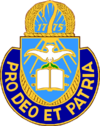
The Chaplain Corps of the United States Army consists of ordained clergy who are commissioned Army officers as well as enlisted soldiers who serve as assistants. Their purpose is to offer religious services, counseling, and moral support to the armed forces, whether in peacetime or at war.
Army Chaplain Center and School
Further information: Armed Forces Chaplaincy CenterThe U.S. Army Chaplain Center and School (USACHCS)[3] is part of the Armed Forces Chaplaincy Center (AFCC), which also includes the Air Force Chaplain Service Institute (AFCSI) and the U.S. Naval Chaplaincy School and Center (NCSC). The three schools are co-located at Fort Jackson, in Columbia, S.C.[4]
In 2005, the Base Realignment and Closure Commission decided to put all military ministry training at the same location.[4]
The purpose of the AFCC is to have closer cooperation among the three chaplain corps and to share instruction and training.[4]
The U.S. Army Chaplain School was approved on 9 February 1918. Its first session began on 3 March 1918, at Fort Monroe, Virginia.[5] Chaplain (MAJ) Aldred A. Pruden, who developed the plan for the school, was named the first commandant of the school.[5] It subsequently moved to Camp Zachary Taylor (Kentucky), Camp Grant (Illinois), Fort Leavenworth (Kansas), Fort Benjamin Harrison (Indiana), Harvard University (Massachusetts), Fort Devens (Mass.), Fort Oglethorpe (Georgia), Carlisle Barracks (Pennsylvania), Fort Slocum (New York) (1951–62), Fort Hamilton (N.Y.) (1962–74), Fort Wadsworth (N.Y.) (1974–79), and Fort Monmouth (New Jersey) (1979–95).[5]
Noncombatant status
Chaplain assistants
Main article: Chaplains assistantsSpecialty insignia
- See: United States military chaplain symbols
- For FAQs regarding uniforms and insignia, see footnote.[6]
Chiefs of Army Chaplains
Main article: Chief of Chaplains of the United States ArmyThe Chief of Chaplains of the United States Army is the head of the Army Chaplaincy. The position was created to better organize the corps. The current Chief of Chaplains is Major General Donald L. Rutherford who was sworn in on July 22, 2011.
Deputy Chief of Army Chaplains
Main article: Deputy Chief of Chaplains of the United States ArmyArmy bases chaplaincy
- See footnotes[7][8]
- For a link to the chaplaincy at each of the bases listed below, see general footnote[9] and the footnote following each base
- Walter Reed Medical Center
Joint-base chaplaincy
A Roman Catholic army chaplain celebrating a Mass for Union soldiers and officers during the American Civil War (1861–1865).
U.S. Military Academy chaplaincy
Chapels
Main article: West Point Cadet ChapelSee also: West Point Jewish Chapel, Chapel of the Most Holy Trinity (West Point), and Old Cadet Chapel (West Point)- For all six USMA chapels, see footnote[24]
Chaplains
- See footnote[25]
Cadet Prayer
- See footnote[26]
Museum
- See also: National Museum of the United States Army and Museum of Army Chaplaincy (U.K.)
- For USA Civil War chaplains, see footnote.[27]
- For historic photographs of Army chaplains in World War I, World War II, the Korean War, and the Vietnam War, see footnote.[28]
The U.S. Army Chaplain Museum is located at Fort Jackson, South Carolina.[29] It was established on 14 August 1957, at the then–United States Army Chaplain School at Fort Slocum, New York. It was dedicated on 10 February 1958, by Chaplain (MG) Patrick J. Ryan, Chief of Chaplains.[30]
"The Four Chaplains"
When the troop-transport ship USAT Dorchester was torpedoed during World War II, four Army chaplains ministered to the soldiers and sailors on the sinking ship, gave up their life jackets, and sacrificed their lives when the ship sank.[31] Those chaplains – known as "The Four Chaplains" – were Lt. George L. Fox, Methodist; Lt. Alexander D. Goode, Jewish; Lt. John P. Washington, Roman Catholic; and Lt. Clark V. Poling, Dutch Reformed.
Other Notable Chaplains
- John G. Burkhalter - Chaplain during World War II and the Korean War.
- John B. DeValles – Chaplain during World War I.
- Francis P. Duffy – Chaplain during World War I, the most highly decorated cleric in the history of the U.S. Army.
- Thomas Dyer – Army's first Buddhist Chaplain; cessioned 14 May 2008 from the Tennessee National Guard.
- Dale Goetz – Chaplain during Afghanistan War. First U.S. Army chaplain to be killed in action since the Vietnam War.[32]
- Philip Hannan – Chaplain during World War II
- Herman G. Felhoelter – Chaplain during the Korean War. Killed in Chaplain–Medic massacre.[33]
- Emil J. Kapaun – Chaplain during the Korean War. Died in a POW camp on 23 May 1951.
- Charles Liteky – Chaplain during Vietnam War. Awarded the Medal of Honor.
- Colman O'Flaherty – Chaplain during World War I. Awarded the Distinguished Service Cross posthumously.
- H. Timothy Vakoc – Chaplain during Iraq War. First U.S. military chaplain to die from wounds received in the Iraq War.
- Charles J. Watters – Chaplain during the Vietnam War. Awarded the Medal of Honor posthumously.
Hymn
- See: Eternal Father, Strong to Save (including special verses for West Point cadets, U.S. armed forces, wounded in combat, and for those deployed)
See also
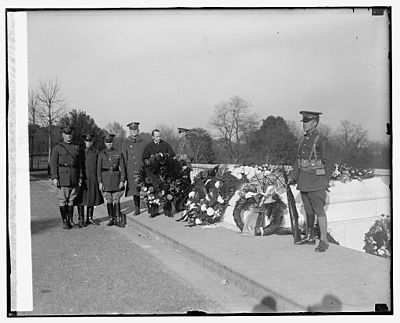 Army chaplains at the Tomb of the Unknowns, in Arlington National Cemetery.
Army chaplains at the Tomb of the Unknowns, in Arlington National Cemetery.
- United Church, The Chapel on the Hill (former Army chapel)
- Military chaplain#United States (including conflicts and criticism)
- United States Air Force Chaplain Corps
- United States Navy Chaplain Corps
- Religious Programs Specialist (Navy)
- Chaplain of the Coast Guard
- Chaplain of the United States Marine Corps
- Armed Forces Chaplains Board (AFCB)
- Chaplains Hill (Arlington National Cemetery)
- Chaplain
- Minister
- Imam
- Priest
- Rabbi
Footnotes
- ^ Army Chaplain Corps: Chaplain Basic Officer Leadership Course. GoArmy.com. Retrieved 4 March 2010.
- ^ Training Directorate. (United States Army Chaplaincy official homepage). Retrieved 4 March 2010.
- ^ US Army Chaplain Center & School (United States Army Chaplaincy official homepage). Retrieved 4 March 2010.
- ^ a b c "First Group of Navy Chaplains Graduate from NSCS Fort Jackson". Navy.mil (USN official website), 11/10/2009. By Steve Vanderwerff, Naval Education and Training Command Public Affairs. Retrieved 3 December 2009.
- ^ a b c Chaplaincy History & Museum: History of Chaplain Corps. US Army Chaplain Corps (United States Army Chaplaincy official homepage). Retrieved 4 March 2010.
- ^ Chaplaincy History & Museum: FAQ's (United States Army Chaplaincy official homepage). Retrieved 5 March 2010.
- ^ Wise, Jeremy (Army Flier Staff) (18 February 2010). "Fort Rucker officials break ground on new post chapel". Army.mil. http://www.army.mil/-news/2010/02/18/34668-fort-rucker-officials-break-ground-on-new-post-chapel/. Retrieved 5 March 2010.
- ^ Schuette, Rob (Fort McCoy Public Affairs) (12 January 2010). "Fort McCoy chapels get major makeovers". Army.mil. http://www.army.mil/-news/2010/01/12/32812-fort-mccoy-chapels-get-major-makeovers/. Retrieved 5 March 2010.
- ^ Go to Office of the USMA Chaplain and click on "Links" in left-hand column. USMA website. Retrieved 4 March 2010.
- ^ At Fort Carson official website, go to "Services" and click on "Chaplain". For photos of the five chapels, then click on "Chapels at Fort Carson". Retrieved 2011-08-19.
- ^ Fort Gordon Chaplain & Ministry Team. Fort Gordon Garrison official website. Retrieved 2011-08-19.
- ^ Office of the Senior Chaplain. Fort Knox official website. Retrieved 2011-08-19.
- ^ Command Chaplain. U.S. Army Combined Arms Center (CAC) official website. Retrieved 2011-08-19.
- ^ Religious Services. Fort Monroe official website. Retrieved 2011-08-19.
- ^ Home page. Fort Polk Command Chaplain Office official website. Retrieved 2011-08-19.
- ^ Fort Polk Chapels. Fort Polk Command Chaplain Office official website. Retrieved 2011-08-19.
- ^ Religious Support. Fort Sill official website. Retrieved 2011-08-19.
- ^ Fort Sill Chapels. Fort Sill official website. Retrieved 2011-08-19.
- ^ Joint Base Lewis-McChord Chaplaincy official website. Retrieved 2011-08-19.
- ^ Fort Dix Command Chaplain Section (including Soldiers Chapel and Dix Chapel). Army Support Activity–Dix (ASA-Dix) official website. Retrieved 2011-08-19.
- ^ JB Chapel Schedule (and contact information) (McGuire Chapel, North Chapel, Dix Chapel, Chapel of the Air). JB MDL Chapel official website. Retrieved 2011-08-19.
- ^ Home page. JB MDL Chapel official website. Retrieved 2011-08-19.
- ^ JB MDL Chapels. JB MDL official website. Retrieved 2011-08-19.
- ^ Go to Office of the USMA Chaplain and click on "Chapels" in left-hand column. USMA official website. Retrieved 23 December 2009.
- ^ Go to Office of the USMA Chaplain and click on "Chaplains" in left-hand column. USMA official website. Retrieved 23 December 2009.
- ^ Go to Office of the USMA Chaplain and click on "Cadet Prayer" in left-hand column. USMA official website. Retrieved 23 December 2009.
- ^ "USA Chaplains". The National Civil War Chaplains Museum. http://www.chaplainsmuseum.org/i/?page_id=231. Retrieved 2011-10-20.
- ^ Chaplaincy History & Museum: Historic Photos (World War I, World War II, Korean War, Vietnam War). US Army Chaplain Corps (United States Army Chaplaincy official homepage). Retrieved 5 March 2010.
- ^ Chaplaincy Museum (United States Army Chaplaincy official homepage). Retrieved 4 March 2010.
- ^ Chaplaincy History & Museum: History (United States Army Chaplaincy official homepage). Retrieved 4 March 2010.
- ^ The Four Chaplains Memorial Foundation. Retrieved 1 December 2009.
- ^ Capt. Goetz joined the Chaplain Corps in 2000. Before that, he was pastor of the First Baptist Church in White, South Dakota. "Army: Chaplain is 1st killed in action since '70: Captain based at Fort Carson, Colo., had hitched ride on supply convoy". NBC News (msnbc.com). 2 September 2010. http://www.msnbc.msn.com/id/38977236/ns/world_news-south_and_central_asia. Retrieved 2 September 2010.
- ^ At the following webpage, scroll down to "Captain Herman G. Felhoelter • Korean War • 1914-1950". Centner, Pat. "No Greater Love: A Memorial Day Salute to Military Chaplains". American Family Association. http://afajournal.org/2003/may/503_chaplains_dw.html. Retrieved 2011-11-06. "A Catholic priest from Washington state, Chaplain Herman Felhoelter had been assigned to the U.S. Army’s 19th Infantry Regiment. .... Four days before his death, he had written his mother: 'Don’t worry, Mother. God’s will be done. I feel so good to know the power of your prayers accompanying me. ... I am happy in the thought that I can help some souls who need help. ...'"
Further reading
External links
- US Army Chaplain Corps (United States Army Chaplaincy official homepage). Retrieved 2010-03-04.
- U.S. Army Chaplaincy (DACH). Army.mil/Chaplaincy. Retrieved 2010-03-05.
- Army Chaplain Corps: Overview. GoArmy.com. Retrieved 2010-03-04.
- Army Chaplain Corps: About Army Chaplains. GoArmy.com. Retrieved 2010-03-04.
- Army Chaplain Corps: Chaplain Candidate Program. GoArmy.com. Retrieved 2010-03-04.
- US Army Chaplain Center & School website. Retrieved 2011-02-24.
- Chaplaincy Museum (U.S. Army Chaplaincy official homepage). Retrieved 2011-02-24.
- Zach Morgan (Fort Polk Guardian staff writer), Chaplain Corps crucial to Army. Army.mil. 19 February 2010. Retrieved 2010-03-05.
- Kelvin Davis (Chief of Chaplains), Civilian Clergy Resources: Ministering to Families Affected by Military Deployment. 4 June 2009. Army.mil (U.S. Army official homepage). Retrieved 2010-03-05.
- Military Chaplains Association (MCA) official website. Retrieved 2009-12-03.
- National Conference on Ministry to the Armed Forces (NCMAF) official website. Retrieved 2009-12-03.
- The Four Chaplains Memorial Foundation official website
- Library of Congress audio and video history interviews of former U.S. military chaplains
Leadership Secretary of the Army · Under Secretary of the Army · Chief of Staff · Vice Chief of Staff · 4-star generals · Sergeant Major of the Army · House Armed Services Committee (House Subcommittee on Air and Land Forces) · Senate Committee on Armed Services (Senate Subcommittee on Air and Land Forces)

Components and
commandsArmy CommandsService ComponentsForces · Africa · Central · Europe · Pacific · North · South · Special Operations · Surface Deployment and Distribution · Space and Missile Defense
Direct Reporting UnitsNetwork Enterprise Technology · Medical · Intelligence and Security · Criminal Investigation · Corps of Engineers · Military District of Washington · Test and Evaluation Command · Military Academy · Reserve · Acquistion Support Center · Installation Management
Field ArmiesBranchesAcquistion Corps · Adjutant General's Corps · Air Defense Artillery Branch · Armor Branch · Aviation Branch · Army Band · Chaplain Corps · Chemical Corps · Civil Affairs Corps · Corps of Engineers · Dental Corps · Field Artillery Corps · Finance Corps · Infantry Branch · Inspector General's Corps · Judge Advocate General's Corps · Logistics Branch · Medical Corps · Medical Service Corps · Medical Specialist Corps · Military Intelligence Corps · Military Police Corps · Nurse Corps · Ordnance Corps · Psychological Operations Corps · Quartermaster Corps · Signal Corps · Special Forces · Transportation Corps · Veterinary Corps
Installations Training Uniforms and insignia Equipment History and traditions History · Continental Army · National Army · Army of the United States · United States Army Air Forces · Center of Military History · Institute of Heraldry · America's Army · Army Art Program · Army Band · Old Guard Fife and Drum Corps · Flag · National Museum · Rangers · Soldier's Creed · The Army Goes Rolling Along · Draft · Service numbers Category ·
Category ·  Portal
PortalChiefs of Chaplains Major General Donald Rutherford (Army) • Rear Admiral Mark Tidd (Navy) • Major General Cecil Richardson (Air Force)Senior USMC/USCG Chaplains
(working under USN Chief of Chaplains)Rear Admiral Margaret Kibben (Chaplain of the United States Marine Corps, and Deputy Chief of Chaplains of the U.S. Navy) • Captain Gary Weeden (Chaplain of the Coast Guard)Chiefs of Chaplains (members) MG Douglas L. Carver (USA Chief of Chaplains)
RADM Mark L. Tidd (USN Chief of Chaplains)
Maj Gen Cecil R. Richardson (USAF Chief of Chaplains)Deputy Chiefs of Chaplains (members) BG Donald L. Rutherford (USA Deputy Chief of Chaplains)
RDML Margaret G. Kibben (USN Deputy Chief of Chaplains/ Chaplain of the USMC)
Brig Gen Howard D. Stendahl (USAF Deputy Chief of Chaplains)Executive Director (staff) COL Thomas E. Preston (USA Chaplain)Categories:- United States military chaplaincy
- Branches of the United States Army
- Religious occupations
- Religion in the United States military
Wikimedia Foundation. 2010.

